Did you know legumes, like black beans, are full of protein? They can make you feel full for a long time. A cup of cooked black beans has about 15 grams of protein. This makes them a great addition to any meal.
Cooking black beans from scratch gives them deeper flavors and a creamier texture. In this tutorial, I’ll show you how to cook black beans. You’ll learn about their nutritional benefits, different cooking methods, seasoning options, and how to store them. By the end, you’ll know how to make delicious homemade black beans.
Key Takeaways
- Cooking black beans from scratch enhances flavor and texture.
- A single cup of cooked black beans provides 15 grams of protein.
- Homemade black beans are versatile for various recipes.
- Proper cooking and seasoning can elevate black beans as a stand-alone dish.
- Understanding different cooking methods will improve your culinary skills.
Understanding Black Beans: Nutritional Benefits
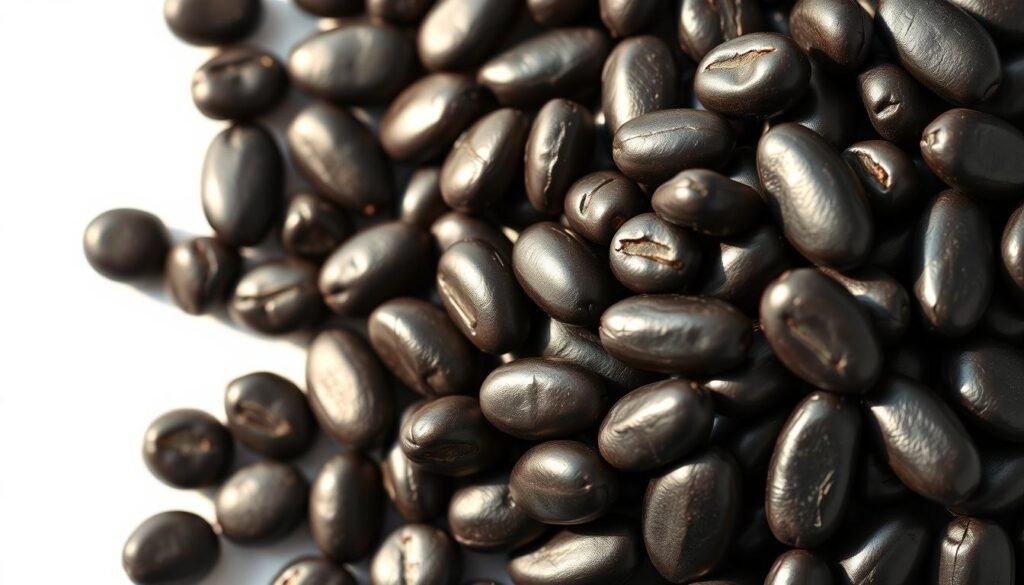
Black beans are more than just a tasty ingredient. They are a nutritional powerhouse. They are packed with protein, fiber, and vitamins. This makes them a key part of a healthy diet.
What Are Black Beans?
Black beans, also known as black turtle beans, come from Central and South America. They are known for their rich flavor and texture. They are a staple in many cuisines, including Latin American dishes.
My experience cooking with black beans shows their versatility. They are great for soups, salads, and more.Learn more about how-to-cook-ribs-in-the-oven.
Nutritional Profile of Black Beans
The nutritional profile of black beans is impressive. A cup of black beans contains:
| Nutrient | Amount per Cup |
|---|---|
| Protein | 15 grams |
| Fiber | 15 grams |
| Carbohydrates | 40 grams |
| Fat | 0.9 grams |
| Iron | 20% of the Daily Value |
| Folate | 64% of the Daily Value |
Health Benefits of Including Black Beans in Your Diet
Adding black beans to my diet has many health benefits. They are great for digestive health because of their fiber. This fiber helps with regular bowel movements and prevents constipation.
Black beans also support heart health. They help lower cholesterol and manage blood pressure. Their protein and fiber help with weight management, keeping me full longer. Including black beans in my meals makes them more nutritious and balanced.
Types of Black Beans Available
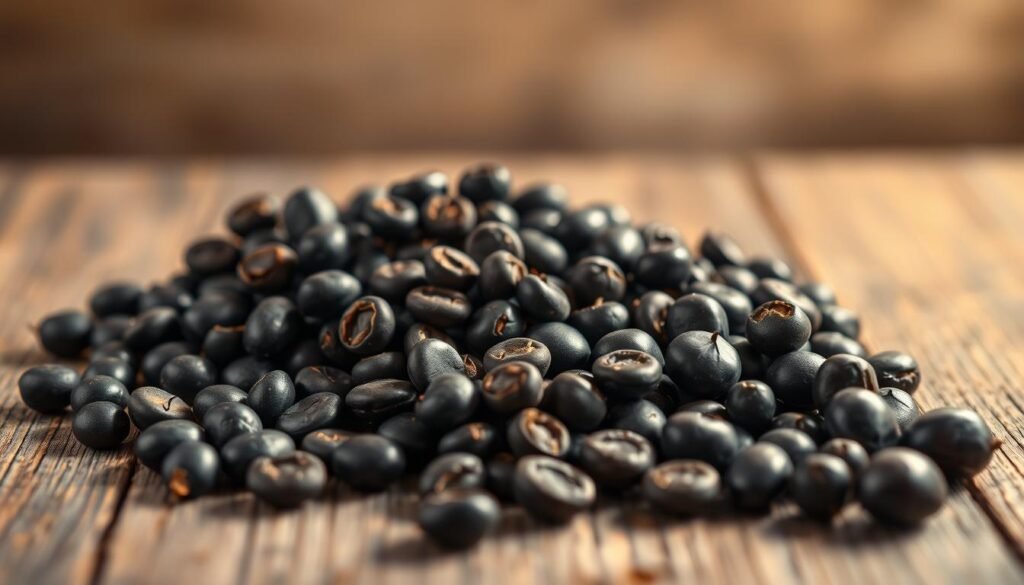
When you look into black beans, you’ll find two main types: canned and dried. Each has its own benefits, so it’s key to pick what suits you best.
Canned vs. Dried Black Beans
Canned black beans are quick and easy. They’re pre-cooked and seasoned, ready to add to your dishes. This is great for busy days when you’re short on time.
Dried black beans, on the other hand, have a richer taste and a chewier texture. I like to soak and cook them. They soak up flavors well, making my meals taste better.Learn more about how-long-to-cook-chicken-breast-in-air-fryer.
Organic vs. Non-Organic Black Beans
Choosing between organic and non-organic black beans affects your health and the planet. Organic beans are grown without harmful chemicals. This makes them safer for you and the environment.
While non-organic beans might be cheaper, the benefits of organic are worth it. I feel good knowing I’m choosing a healthier option for my family and supporting green farming.
| Type | Preparation Time | Flavor | Health Benefits |
|---|---|---|---|
| Canned Black Beans | Ready to use | Good | Convenient source of protein |
| Dried Black Beans | Soaking and cooking time required | Rich and hearty | Higher fiber content |
| Organic Black Beans | Various (canned or dried) | Best flavor | Free from chemicals |
| Non-Organic Black Beans | Various (canned or dried) | Good | Cost-effective |
Preparing Dried Black Beans for Cooking
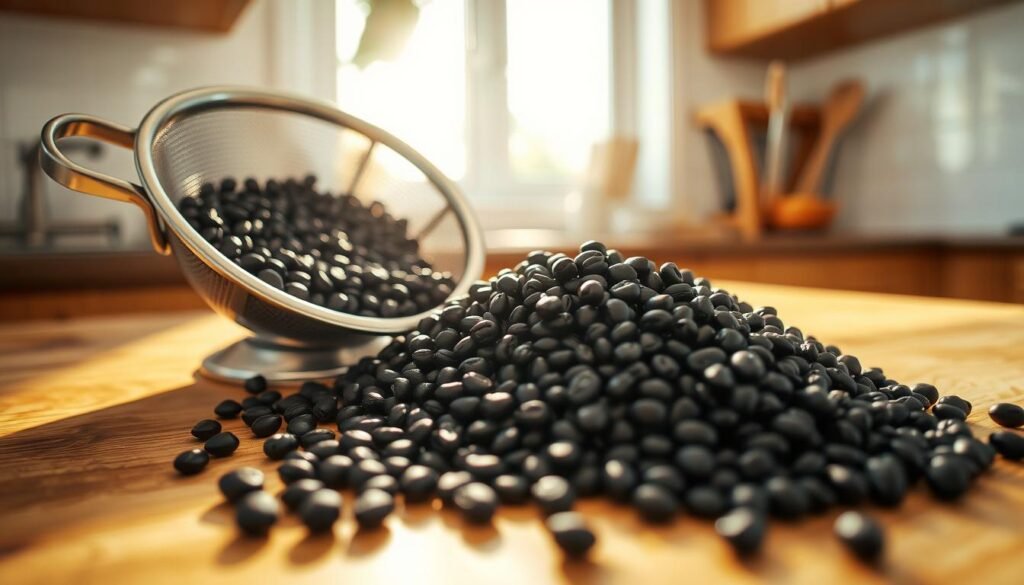
Getting dried black beans ready is key for great taste and texture. I start by sorting black beans to get rid of stones or bad beans. This first step makes sure my food is clean and safe.
Next, I rinsing black beans well under cold water. This step removes dirt and makes them cleaner. After these steps, I choose how to soak the beans to make them better before cooking.
Sorting and Rinsing Black Beans
Sorting black beans is easy but important. I check each bean and throw away the bad ones. Then, I rinse them under cold water to get rid of any dirt.
Soaking Methods: Overnight vs. Quick Soak
After rinsing, I pick between two soaking methods. The first is soaking them in water for 8 to 12 hours. This makes them easier to digest and cooks them faster.
The second method is quick soaking. I boil them for a few minutes and then let them sit for an hour. Both ways make the beans tender and ready for a tasty meal. Here’s a look at both methods.
| Soaking Method | Duration | Benefits |
|---|---|---|
| Overnight Soak | 8-12 hours | Improves digestibility, reduces cooking time |
| Quick Soak | 1 hour | Speedy preparation |
Cooking Black Beans on the Stovetop
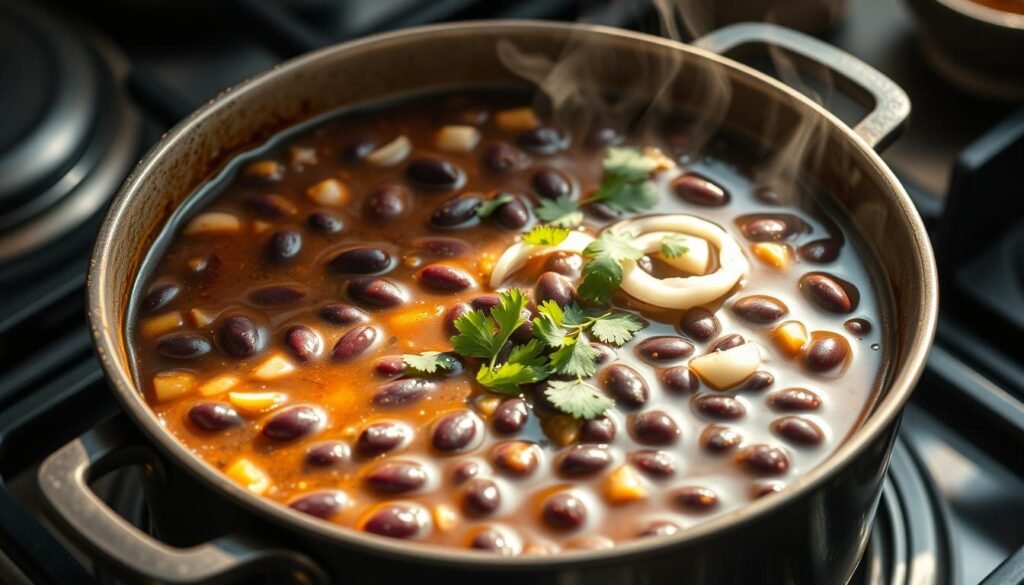
Cooking black beans on the stove is easy and healthy. With the right ingredients and steps, they become tender and tasty. They’re great in many dishes.Learn more about how-to-cook-filet-mignon.
Essential Ingredients for Stovetop Cooking
- Dried black beans
- Water
- Salt
- Diced onions
- Garlic cloves
- Bay leaf (optional)
Step-by-Step Cooking Instructions
- First, sort and rinse the dried black beans. This removes any dirt or bad stuff.
- In a big pot, mix the sorted beans with water that covers them by a few inches. Add diced onions, garlic, and a bay leaf for extra taste.
- Heat the mix to a boil on medium-high.
- After boiling, turn the heat down to low and cover the pot. Let the beans simmer.
- Check if the beans are tender after about 1.5 hours. Cooking time can change based on the beans’ freshness.
- When the beans are tender, add salt to taste. You can also add more spices or herbs.
Cooking Black Beans in a Pressure Cooker
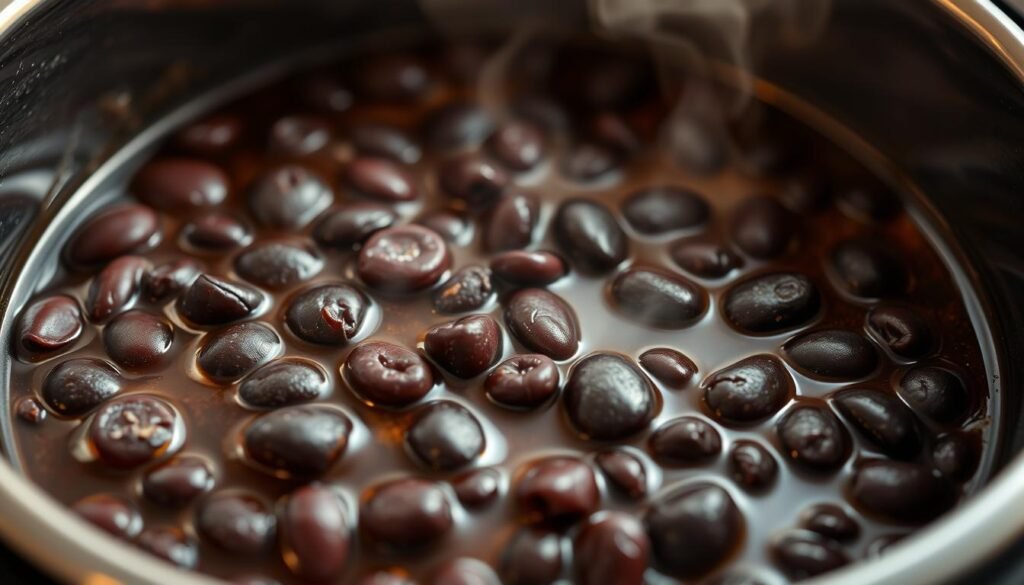
Using a pressure cooker for black beans saves time and makes cooking better. It cooks faster and keeps flavors consistent. The intense heat and steam help keep nutrients and flavor in the beans. I think it’s the best way to cook them.
Benefits of Using a Pressure Cooker
A pressure cooker changes how you cook black beans. It saves a lot of time compared to old ways. Soaking the beans first makes cooking even quicker.
This method ensures the beans cook evenly. They turn out perfectly tender. There’s less chance of them becoming mushy or dry.
Pressure Cooking Time and Tips
Here are the typical cooking times for a pressure cooker:
| Type of Black Beans | Soaked Beans (Natural Release) | Soaked Beans (Quick Release) | Unsoaked Beans (Quick Release) |
|---|---|---|---|
| Cooking Time | 5-6 minutes | 9 minutes | 20 minutes |
For the best results, rinse and sort the beans first. This removes any bad stuff. Make sure there’s enough liquid to avoid burning.
Seasoning with garlic, onion, or herbs adds great flavor. For more tips, check out this link: cooking black beans in a pressure cooker. This way, you’ll get soft, tasty beans fast.
Cooking Black Beans in a Slow Cooker
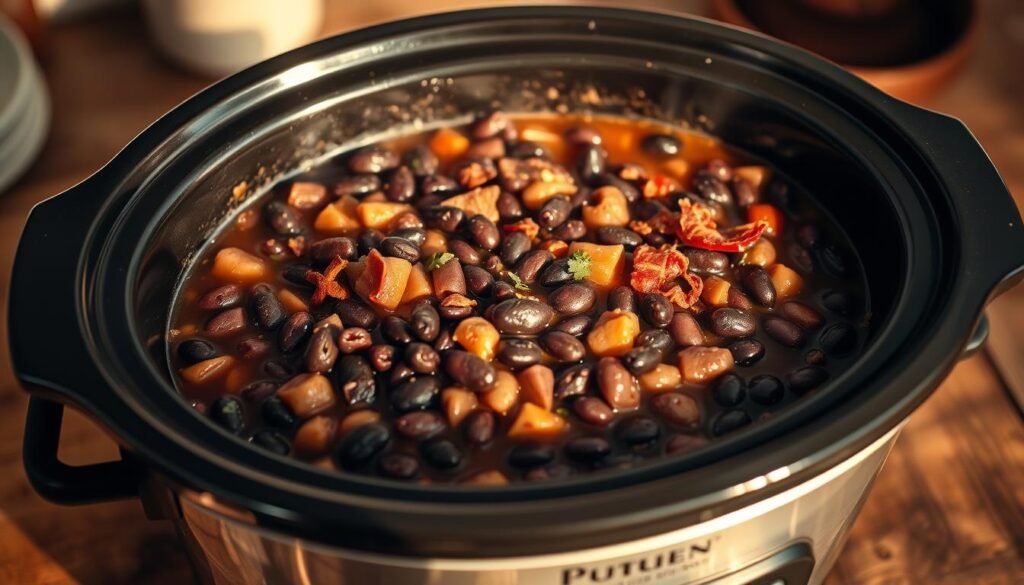
Cooking black beans in a slow cooker is a game-changer. It lets the flavors meld together beautifully, making every meal rich and satisfying. The low heat keeps the beans creamy, ensuring a perfect dish every time.Learn more about how-long-to-cook-pork-chops-in-oven.
Advantages of Slow Cooking
Slow cooking black beans is incredibly convenient. Here’s why I love it:
- Hands-off cooking: Just put everything in and forget about it.
- Flavor development: The low heat infuses spices and aromatics into the beans.
- Consistency: You get evenly cooked beans every time.
Recommended Slow Cooker Recipe
Want to try a simple black beans recipe? Here’s a hassle-free way to make slow cooker black beans:
| Ingredients | Amount |
|---|---|
| Dried black beans | 1 lb. |
| Onion (halved) | 1 small |
| Bay leaf | 1 |
| Garlic (smashed and halved) | 1 clove |
| Kosher salt | 2 to 4 teaspoons |
| Crushed red pepper flakes (optional) | 1/2 to 1 teaspoon |
| Olive oil (optional) | 1/4 cup |
| Water | 8 cups |
Just add all the ingredients to the slow cooker and cover with water. Cook on high for 6 to 8 hours, checking at 4 hours. Taste and adjust the salt as needed. For a detailed guide, check this simple slow cooker black beans recipe.
Flavoring Black Beans: Seasoning Options
Seasoning black beans makes them more than just healthy. I start with salt and black pepper, then add garlic for a nice aroma. Spices like cumin, chili powder, and bay leaves bring out the beans’ flavor. These seasonings make the beans taste amazing by soaking into them.
Essential Seasonings for Black Beans
When I cook black beans, I use a few key seasonings:
- Salt
- Black pepper
- Garlic
- Cumin
- Chili powder
- Bay leaves
These basics are the start of many tasty black bean flavors.
Popular Flavor Combinations
I love mixing black beans with fresh and zesty ingredients. Lime juice adds a tangy taste, and cilantro brings a fresh herbal flavor. Smoked paprika adds a smoky, savory taste that makes the beans cozy.
Diced jalapeños or hot sauce can also add a spicy kick. For more ideas, check out spicy seasoned black beans.
Trying different seasonings is the best way to find your favorite dish. Black beans can be paired with many flavors, making cooking fun and creative.
Serving Suggestions for Black Beans
Black beans are super versatile and can make any meal better. They add flavor and nutrition to many dishes. You can use them in soups, salads, and more, making them a great addition to your meals.
Incorporating Black Beans into Meals
There are many ways to use black beans in your cooking. I enjoy making a black bean salad with fresh veggies. They also go well with rice or as a taco filling, adding a rich flavor.
Pairing them with quinoa is another great idea. It makes a healthy base for toppings and salsas.
Creative Recipe Ideas with Black Beans
Black beans offer endless recipe possibilities. I make black bean burgers that are tasty and protein-rich. Black bean tacos with avocado, salsa, and cheese are also a hit.
For something different, I make black bean soup. It’s full of flavor. I also use black beans in breakfast dishes, like topping them with avocado and cilantro.
For more ideas on using black beans, check out this collection of black bean recipes. It’s full of creative ideas.
Storing Cooked Black Beans
Storing cooked black beans right is crucial for their taste. I use airtight containers to keep them fresh, mainly in the fridge. They stay good for up to 5 days there. For longer storage, freezing is the way to go. They freeze well and can last months without losing flavor.
Best Practices for Storage
Freezing cooked black beans is easy, and I keep them in their cooking liquid. This keeps them moist and prevents them from drying out. I always label the containers with the date before freezing. This helps me keep track of how long they last and plan meals better.
How Long Do Cooked Black Beans Last?
Proper storage lets me enjoy black beans whenever I want. Whether in the fridge for a few days or frozen for longer, knowing how to store them is key. For more tips, check out this resource on black beans. This way, I’m always ready to enjoy their health benefits in my meals.
FAQ
How do I know if my black beans are fresh?
Fresh black beans are firm and glossy. They should not have cracks. If they look dull or smell off, they’re not fresh.
Can I cook black beans without soaking them?
Yes, you can cook black beans without soaking. But, it takes longer. Soaking makes them taste better and feel softer.
Are black beans gluten-free?
Absolutely! Black beans are naturally gluten-free. They’re a great protein choice for those with gluten issues.
Can I add other ingredients while cooking black beans?
Yes, you can add things like diced bell peppers or spices. Just remember, it might change the cooking time.
How can I tell when black beans are done cooking?
They’re done when they’re tender but still firm. You can taste them to check.
What can I do with leftover black beans?
Use leftover black beans in salads, soups, or tacos. You can also freeze them for later.
Is it necessary to season black beans before cooking?
Seasoning black beans while cooking makes them taste better. Use salt, garlic, and onion for flavor.
How can I make my black beans creamier?
To make them creamier, mash some beans or add broth or cream. This will help.
What are some common dishes that use black beans?
Black beans are in tacos, burritos, chili, salads, and side dishes. They’re versatile.
Can I use canned black beans in place of dried beans?
Yes, canned black beans work too. Just rinse and drain them for better taste and texture.
